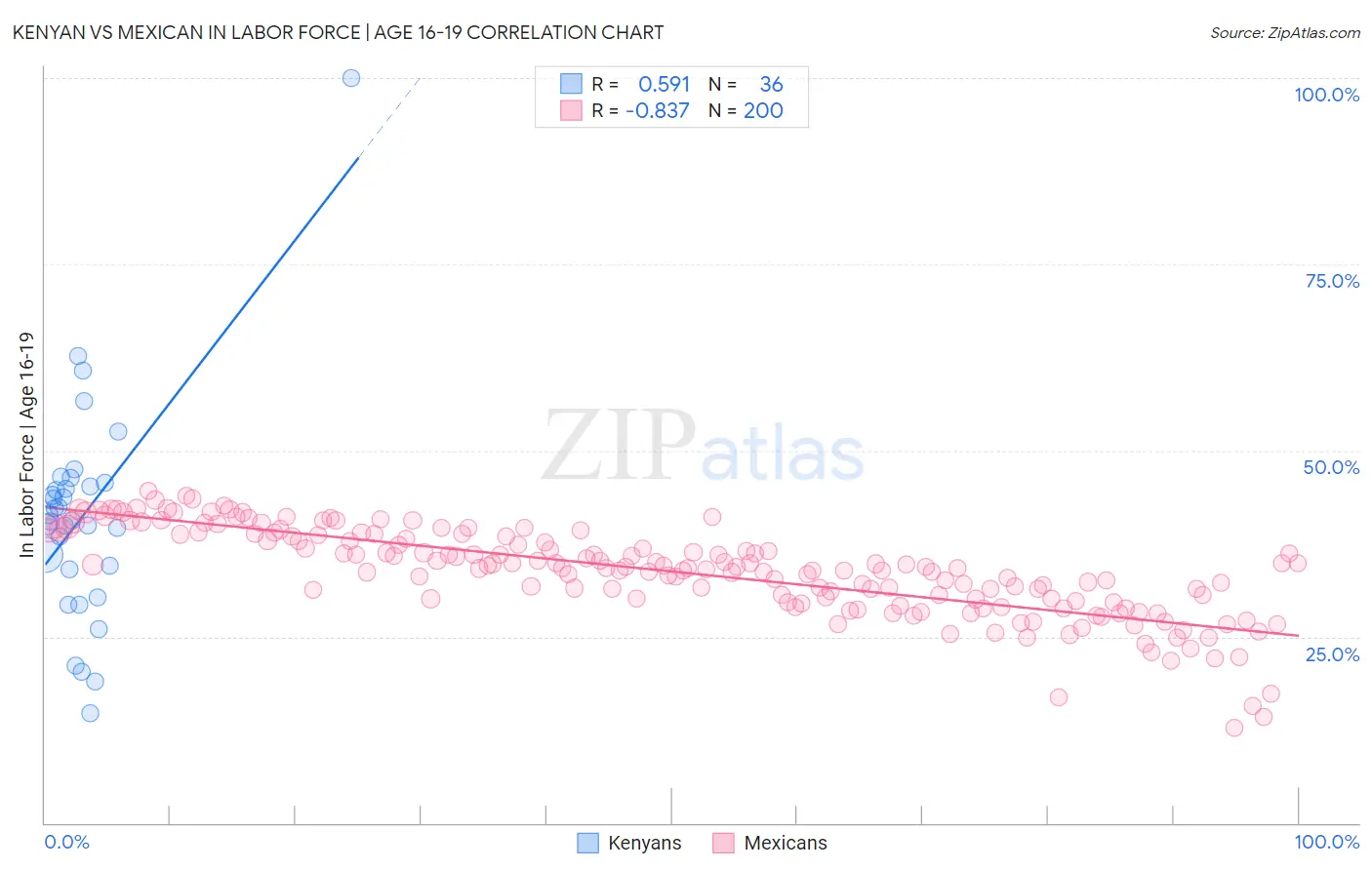Kenyan vs Mexican In Labor Force | Age 16-19
COMPARE
Kenyan
Mexican
In Labor Force | Age 16-19
In Labor Force | Age 16-19 Comparison
Kenyans
Mexicans
40.1%
IN LABOR FORCE | AGE 16-19
100.0/ 100
METRIC RATING
65th/ 347
METRIC RANK
35.6%
IN LABOR FORCE | AGE 16-19
11.9/ 100
METRIC RATING
211th/ 347
METRIC RANK
Kenyan vs Mexican In Labor Force | Age 16-19 Correlation Chart
The statistical analysis conducted on geographies consisting of 168,228,993 people shows a substantial positive correlation between the proportion of Kenyans and labor force participation rate among population between the ages 16 and 19 in the United States with a correlation coefficient (R) of 0.591 and weighted average of 40.1%. Similarly, the statistical analysis conducted on geographies consisting of 561,746,144 people shows a very strong negative correlation between the proportion of Mexicans and labor force participation rate among population between the ages 16 and 19 in the United States with a correlation coefficient (R) of -0.837 and weighted average of 35.6%, a difference of 12.6%.

In Labor Force | Age 16-19 Correlation Summary
| Measurement | Kenyan | Mexican |
| Minimum | 14.8% | 12.7% |
| Maximum | 100.0% | 44.6% |
| Range | 85.2% | 31.8% |
| Mean | 41.2% | 33.8% |
| Median | 41.0% | 34.3% |
| Interquartile 25% (IQ1) | 34.3% | 30.0% |
| Interquartile 75% (IQ3) | 45.4% | 38.7% |
| Interquartile Range (IQR) | 11.1% | 8.7% |
| Standard Deviation (Sample) | 14.8% | 6.0% |
| Standard Deviation (Population) | 14.6% | 6.0% |
Similar Demographics by In Labor Force | Age 16-19
Demographics Similar to Kenyans by In Labor Force | Age 16-19
In terms of in labor force | age 16-19, the demographic groups most similar to Kenyans are Immigrants from Micronesia (40.2%, a difference of 0.080%), Nonimmigrants (40.1%, a difference of 0.12%), Canadian (40.1%, a difference of 0.13%), Northern European (40.2%, a difference of 0.19%), and Italian (40.1%, a difference of 0.19%).
| Demographics | Rating | Rank | In Labor Force | Age 16-19 |
| Aleuts | 100.0 /100 | #58 | Exceptional 40.4% |
| Slavs | 100.0 /100 | #59 | Exceptional 40.4% |
| Immigrants | Eastern Africa | 100.0 /100 | #60 | Exceptional 40.4% |
| Americans | 100.0 /100 | #61 | Exceptional 40.3% |
| Cherokee | 100.0 /100 | #62 | Exceptional 40.2% |
| Northern Europeans | 100.0 /100 | #63 | Exceptional 40.2% |
| Immigrants | Micronesia | 100.0 /100 | #64 | Exceptional 40.2% |
| Kenyans | 100.0 /100 | #65 | Exceptional 40.1% |
| Immigrants | Nonimmigrants | 100.0 /100 | #66 | Exceptional 40.1% |
| Canadians | 100.0 /100 | #67 | Exceptional 40.1% |
| Italians | 99.9 /100 | #68 | Exceptional 40.1% |
| Potawatomi | 99.9 /100 | #69 | Exceptional 40.0% |
| Portuguese | 99.9 /100 | #70 | Exceptional 40.0% |
| Serbians | 99.9 /100 | #71 | Exceptional 39.9% |
| Iroquois | 99.9 /100 | #72 | Exceptional 39.9% |
Demographics Similar to Mexicans by In Labor Force | Age 16-19
In terms of in labor force | age 16-19, the demographic groups most similar to Mexicans are Immigrants from Switzerland (35.6%, a difference of 0.0%), Moroccan (35.7%, a difference of 0.10%), Houma (35.6%, a difference of 0.11%), Immigrants from Bolivia (35.6%, a difference of 0.11%), and Apache (35.6%, a difference of 0.12%).
| Demographics | Rating | Rank | In Labor Force | Age 16-19 |
| Immigrants | Albania | 15.0 /100 | #204 | Poor 35.8% |
| South American Indians | 14.6 /100 | #205 | Poor 35.8% |
| Chileans | 14.6 /100 | #206 | Poor 35.8% |
| Immigrants | Eastern Europe | 14.5 /100 | #207 | Poor 35.8% |
| Koreans | 13.3 /100 | #208 | Poor 35.7% |
| Moroccans | 12.7 /100 | #209 | Poor 35.7% |
| Immigrants | Switzerland | 11.9 /100 | #210 | Poor 35.6% |
| Mexicans | 11.9 /100 | #211 | Poor 35.6% |
| Houma | 11.0 /100 | #212 | Poor 35.6% |
| Immigrants | Bolivia | 11.0 /100 | #213 | Poor 35.6% |
| Apache | 11.0 /100 | #214 | Poor 35.6% |
| Immigrants | South Eastern Asia | 10.8 /100 | #215 | Poor 35.6% |
| Dutch West Indians | 10.7 /100 | #216 | Poor 35.6% |
| Immigrants | Costa Rica | 10.7 /100 | #217 | Poor 35.6% |
| Sri Lankans | 9.8 /100 | #218 | Tragic 35.5% |